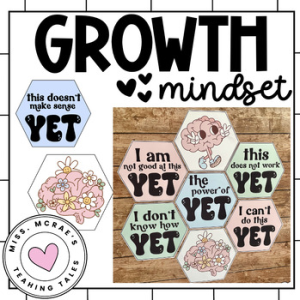77
One of the most significant challenges that educators face in the classroom is not, in fact, teaching new concepts (though, that is a challenge in and of itself). Rather, it’s their students’ beliefs in their abilities to learn new concepts. Students’ mindset can play a big role in how they approach learning, and one of the greatest lessons that educators can teach their students is to nurture a growth mindset.
The concept of a growth mindset is well-known in education circles, thanks in large part to the work of Carol Dweck. It is defined as the belief that one’s abilities and intelligence can be developed through hard work, dedication, and the right strategies. Encouraging students to develop a growth mindset can ultimately help them persevere through, learn from their mistakes, and strive for progress.
So, how can educators help students believe they can achieve? Here are 5 ideas for growth mindset activities that educators can implement in their lessons to teach students about grit, resilience, and adaptability.
5 Ideas for Teaching about a Growth Mindset
Check out these engaging and impactful ideas for helping students develop and nurture a growth mindset.
1. Help students reframe their mindset
The “power of yet” principle encourages students to view their abilities as works in progress, rather than set in stone. During class, help students identify the limiting thoughts of a fixed mindset and give them practice rephrasing those thoughts to reflect a growth mindset. For instance, when a student says, “I’m just not good at math,” a teacher can reframe it by saying, “You’re not good at it yet, but with practice, you can improve.” Practicing reframing is an effective way to help students realize that even if they haven’t achieved something yet, they can with time and effort.
The Power of Yet Display | Classroom Posters | Growth Mindset Bulletin Board
By Miss McRaes Teaching Tales – Beka McRae
Grades: Any
Growth Mindset, Metacognition Strategies & Power of Yet BUNDLE for Middle School
By Diversity in Mind with Abena
Grades: 5-10
Growth vs. Fixed Mindset Scenarios | Growth Mindset Situation Cards | Scenarios
By Queen’s Educational Resources
Grades: 5-12
2. Normalize failure as part of the learning process
Students should feel safe to take intellectual risks without fear of judgment or embarrassment. To foster this kind of environment, educators can help students see mistakes as part of the learning journey and an opportunity for growth, rather than something to be ashamed of. One way to do this is to center a lesson around individuals who were resilient and overcame failure, in order to provide students with real-life examples of what can be achieved in the face of adversity.
Growth Mindset Lesson – Famous Failures
By Rigorous Resources by Lisa
Grades: 4-12
Growth Mindset Famous Failures – Inventors Reading Activity
By the small but mighty teacher
Grades: 4-12
3. Encourage resilience through writing
Journaling can be an excellent tool for fostering a growth mindset in students for many reasons. Mainly, it encourages students to actively process their experience, helps students track their progress, and reinforces the idea that learning and personal growth are ongoing processes. For example, teachers can have students do a daily or weekly reflection, answering prompts like: “How did I improve in an area where I struggled before?” or “What’s a mistake I made that helped me learn something new?” or “How did my efforts contribute to some of my accomplishments?”
Growth Mindset Journal | Mindfulness Activities | SEL Worksheets
By Design Education
Grades: 3-5
Math Growth Mindset | Interactive 5 Day Unit | Student Journal | No Prep | BOY
By Get Techy Wit’ It
Grades: 3-8
Growth Mindset Bell Ringer Journal for Entire Year: Back to School (EDITABLE)
By The SuperHERO Teacher
Grades: 6-12
4. Teach students how to give and receive constructive feedback
Feedback plays a pivotal role in fostering a growth mindset, as it helps students focus their efforts on exactly what they need to work on to improve and take active steps toward growth. By practicing how to give and receive good feedback, students can learn that criticism is an opportunity for improvement, not a reflection of their inherent abilities.
Accepting Feedback | Growth Mindset Series 6 by Eve Coates
By Eve Coates
Grades: 1-4
5. Set learning goals, not just performance goals
By setting learning goals, educators can encourage students to focus on mastering new skills — rather than just getting good grades. Ultimately, goal-setting activities can help guide students toward resilient individuals with the grit and perseverance to pursue and attain their goals. Check out these two blog posts to find everything you’ll need to teach these skills to students:
Want more ideas for lessons or classroom activities to promote a growth mindset? There’s plenty available on TPT.










